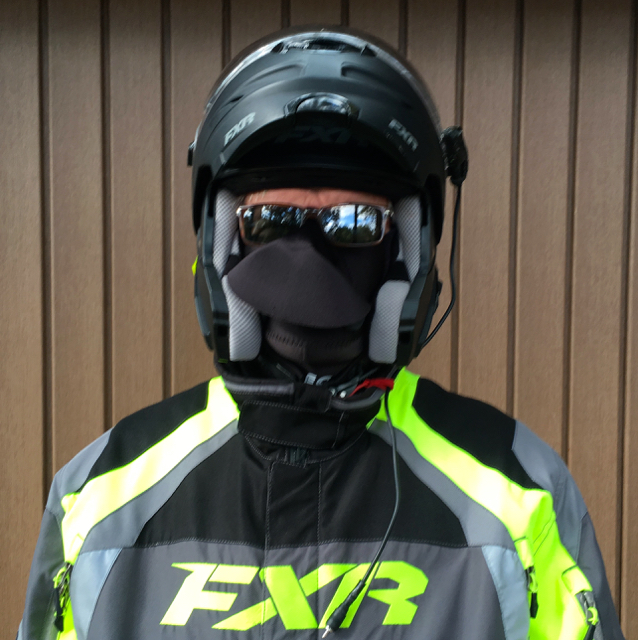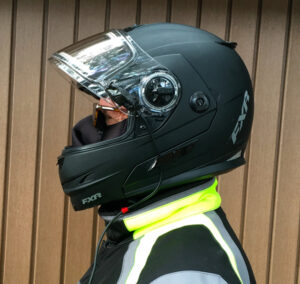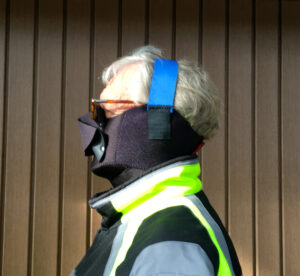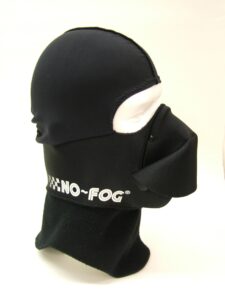Visor Anti-Fogging Makes Snowmobiling Enjoyable…

Related: Choosing The Best Snowmobile Helmet
Why do you need visor anti-fogging tips? Put up a hand if you’ve ever had trouble seeing through your face shield because of fogging up on snowmobile tours.
I bet if you wear eyeglasses while snowmobiling like I do, you’ll have both hands raised. Because then it’s twice as likely your vision suffer has suffered. Fogging up is not only annoying and frustrating on your snowmobile tour or snowmobile vacation. It can be dangerous for snowmobile safety too.
Visor Anti-Fogging Tip #1 – Causes of Fogging
 Fogging happens when warm, moist breath contacts cold surfaces like eyeglass lenses or the inside of a helmet visor. It’s exacerbated by excess heat dissipating from your head. This occurs when your body gets overly hot from physical activity or if your metabolism naturally runs on the warm side.
Fogging happens when warm, moist breath contacts cold surfaces like eyeglass lenses or the inside of a helmet visor. It’s exacerbated by excess heat dissipating from your head. This occurs when your body gets overly hot from physical activity or if your metabolism naturally runs on the warm side.
Meanwhile, the colder the outside air temperature is (lowered even more by the wind chill of zippy riding), the worse fogging (or even icing) can be on your face shield or lenses. So what to do for safe snowmobiling?
Tip #2 – Right Height Windshield
Start by ensuring your snow machine has the right height windshield for body size. You can follow through with every other tip below. But if your windshield deflects cold air directly on to helmet visor, it may be very difficult to keep it clear. I always go for a higher windshield that deflects moving air over my head. This gives my visor anti-fogging measures the best chance to work effectively.
Tip #3 – Right Size Helmet
With so many variables, there’s no one easy solution to improve snowmobile safety. I know that some of you are going to swear by a snocross style helmet and goggles. But I prefer a full face with my glasses. So my anti-fogging starts with a properly fitted helmet. A helmet is supposed to be snug without being too tight. That way it won’t fly off easily in a collision. A right fit also means there’s less space inside for warm, moist air to linger. And it’s more likely the helmet’s built in anti-fogging features will work decently.
Tip #4 – Breath Deflection
 A key premise for anti-fogging is to deflect your breath away from your sightline. I experimented with this one season by using a short swim snorkel with the mouthpiece gripped between my teeth and exhaling breath over my shoulder. Unfortunately, it only worked with an open face helmet. It also made it awkward to talk, and left an unsightly stream of frozen saliva down the back of my jacket. But my idea had merit because a product called Fog Thief adapted a similar approach with a mouthpiece and downward pointing exhalation tubes.
A key premise for anti-fogging is to deflect your breath away from your sightline. I experimented with this one season by using a short swim snorkel with the mouthpiece gripped between my teeth and exhaling breath over my shoulder. Unfortunately, it only worked with an open face helmet. It also made it awkward to talk, and left an unsightly stream of frozen saliva down the back of my jacket. But my idea had merit because a product called Fog Thief adapted a similar approach with a mouthpiece and downward pointing exhalation tubes.
Fortunately today, many helmets come with integrated breath deflectors. These work for riders that don’t breath too hard or generate much heat. Or have face shapes that the deflector fits. Or who don’t wear eyeglasses. If you fit into one or more of these categories, your next best line of defence is an electric face shield and an Oxygen Helmet.
Tip #5 – Electric Face Shield
An electric visor heats up just enough to prevent most fogging inside your shield. But it does little to prevent icing or freezing rain build up on its outside surface. To be hot enough to do that, the heat would likely melt the visor plastic. Instead, try scraping exterior ice off with the edge of a plastic room key).
Except for the Oxygen helmet, electric visors are either on or off, with no incremental heat stages. They can also be a pain when you walk away from your snowmobile forgetting to unplug the visor wire.
Tip #6 – Multiple Vents
Helmet air vents can also be helpful against fogging by letting dry outside air inside to cool things. Multiple vents can keep an airflow going to dissipate head heat. They are far less painfully cold on your face and eyeballs than keeping your visor cracked open while whipping down a snowmobile trail.
Visor Anti-Fogging Tip #7 – No-Fog® Mask
 Since my body temperature tends to run hot, I need to go one step farther to avoid eyeglass fogging. So I remove the helmet’s integrated breath deflector and replace it with a No-Fog Mask. This neoprene face cover has better adjustability to fit my face. It seals the critical areas around my nose and upper cheeks where hot breath tends to leak out.
Since my body temperature tends to run hot, I need to go one step farther to avoid eyeglass fogging. So I remove the helmet’s integrated breath deflector and replace it with a No-Fog Mask. This neoprene face cover has better adjustability to fit my face. It seals the critical areas around my nose and upper cheeks where hot breath tends to leak out.
This way, the No-Fog nosepiece directs all my expelled breath down and out the bottom of my helmet. The No-Fog Mask also protects my cheeks, chin and neck from cold air and frostbite (no balaclava needed). So I’m also able to remove the helmet’s chin skirt to improve the release of hot air.
Tip #8 – Rider Comments
Apparently, I’m not the only one with fogging concerns. Many riders have weighed in with valuable advice ranging from shaving cream to hand soap to VO5 hot oil for hair to prevent fogging…
“Coating the eye glasses each morning with 1/4 teaspoon of shampoo on each side, both lenses and smearing it on and spreading it evenly with your finger. Wait 4 minutes. Come back to the glasses with a cotton t-shirt type material and remove excess shampoo initially then very lightly as possible, sort of buff the lenses so there is no obvious shampoo residue left on the lens but keep in mind to buff very very softy so you actually end up putting down a coating of shampoo that stops any fogging all day!! You’ll see right away as you step outside your motel room and install your luggage to your sled while it’s -10c or so, then walk back into a very hot room. Magically there is zero fogging and zero fogging throughout the day in the helmet!” – Haig Amagoumian
“They sell cream called Cat Crap at Mark’s Work Wearhouse..red round little plastic container, works great. I’m a 4 eyes etc..good product for glasses n lenses etc” – Darrel Christensen
“Put your helmet & glasses outside for 5 to 10 minutes before you put it on, Then do so outside so there’s no temperature change that can cause condensation.” – Chris Scott
My Last Word on Visor Anti-Fogging
Even with all of this, eyeglass fogging can still occur. My anti-fogging tricks include being absolutely sure to position the nose piece of my eyeglasses on the No-Fog mask, not inside it resting on the bridge of my nose. Doing so breaks the seal and places my lenses directly inline with any hot air leakage.
Another tip is that I rarely wear my glasses inside when paying for gas because that sudden in and out changing of temperature is a primary fogger. Same goes for lunch stops, where I leave my riding glasses in the sled and wear a spare pair inside.
Despite my best efforts to be safe snowmobiling, occasionally fogging still obscures my vision. Then my best bet is to get inside someplace warm to thaw and dry my helmet and visor thoroughly before setting out again. Fortunately, I’m usually second time lucky so I can ride the rest of the day clear sighted, what about you?
The tips and advice in this blog are the opinions of the author, may not work in every situation and are intended only for the convenience and interest of the reader, who has the personal responsibility to confirm the validity, accuracy and relevancy of this information prior to putting it to their own use.
